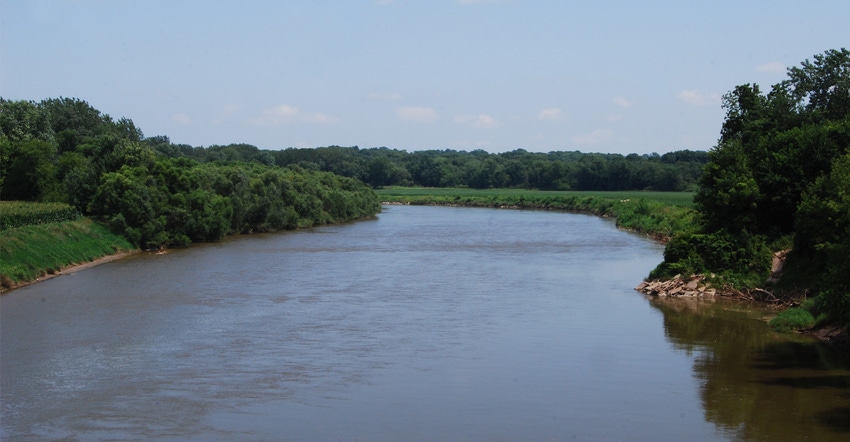
Iowa is making progress on improving and protecting water quality, but a lot more needs to be done. Iowa State University, the Iowa Department of Agriculture and Land Stewardship and the Iowa Department of Natural Resources in mid-December released the Iowa Nutrient Reduction Strategy’s progress report for 2017.
The annual report provides progress updates on point source and nonpoint source efforts to reduce the amount of nitrogen and phosphorus in water leaving the state. The report follows the “logic model” framework that identifies measurable indicators of desirable change that can be quantified. It represents a progression toward the goals of achieving a 45% reduction in nitrogen and phosphorus entering streams, rivers and lakes.
“There are a wide variety of factors that impact water quality, and this report seeks to identify and quantify all of the work being done. We continue to see progress among all aspects of measures that have been identified; we just need to continue to accelerate and scale up our efforts,” says Mike Naig, Iowa deputy secretary of agriculture.
Progress requires scale-up
Chuck Gipp, director of the Iowa DNR, says, “We continue to focus highly on the main goal of water quality improvement, and it is gratifying to see we are moving in that direction. A great deal of collaboration and cooperation has taken place, which has enhanced and continues to enhance the partnerships and teamwork being done to successfully meet our end goals.”
The report explains that the “logic model” framework recognizes that in order to affect change in water quality, there is a need for increased inputs such as funding, staff and resources. Inputs affect change in outreach efforts and human behavior. The shift Iowa is seeing toward more conservation-conscious attitudes in the agricultural community and in the point source community is a desired change in the human dimension of water quality efforts.
With changes in human attitudes and behavior, changes on the land may occur, measured as conservation practice adoption and wastewater treatment facility upgrades. Finally, these physical changes on the land may affect change in water quality, which ultimately can be measured through both empirical water quality monitoring and through modeled estimates of nutrient loads in Iowa surface water.
“While it will take time to reach the 45% reduction goal, the indicators we track are moving in the right direction,” says John Lawrence, interim vice president of Extension and research at Iowa State University. He was one of the Iowa leaders involved in putting together the Iowa Nutrient Reduction Strategy, which was introduced in 2013.
Report highlights
Highlights from the recently released progress report on the Iowa Nutrient Reduction Strategy include the following indicators:
Inputs. Human behavior doesn’t change and practices aren’t implemented without an investment in resources.
• The report identifies $420 million in private and public-sector funding for Iowa Nutrient Reduction Strategy efforts, an increase of $32 million compared to the previous year.
• Since 2013 the Iowa Nutrient Research Center has funded 54 projects with a primary focus on evaluating the performance of current and emerging in-field and edge-of-field practices to reduce nutrient loss.
• Of the 151 municipal wastewater plants and industrial facilities required to assess their nutrient removal capacity, 105 have been issued new permits and 51 of those have submitted feasibility studies on potential technology improvements to reduce nutrient loss.
Human behavior. Changes do not occur on the land and in the cities unless people change their behavior. Indicators of positive change include these measures:
• Meetings, workshops and other outreach events effectively doubled in the last year. In the latest reporting period, partner organizations reported 474 events focused on water quality with 54,500 total attendees.
• In 2017, 77% of farmers surveyed reported that they are knowledgeable about the Iowa Nutrient Reduction Strategy. This is a 9% increase from 2015.
Land. Nothing will change in the water unless changes occur on the land and in the cities’ water treatment facilities. A number of cities in Iowa are upgrading their wastewater treatment facilities.
• Government cost-share programs enrolled 300,000 cover crop acres in 2016. Iowa has experienced a steady increase in cover crop acres since 2011, and statewide estimates (beyond just cost-share) indicate 600,000 acres were planted in 2016.
• Edge-of-field practices that address only nitrogen, such as bioreactors and nitrate-treating wetlands, are just starting to receive increased focus from cost-share programs.
Water. Ultimately, the excess nutrients found in water must be reduced. But where and how do you measure?
• Iowa has an extensive water quality monitoring system in place and at least 88% of Iowa’s land naturally drains to a location with water quality sensors installed and maintained mainly by the Iowa Department of Natural Resources, University of Iowa and the U.S. Geological Survey.
• Water monitoring occurs at various scales, from edge-of-field to large watersheds. Long-term data will lead to better understanding of local and statewide nutrient loss over time.
The report is available at nutrientstrategy.iastate.edu/documents.
About the Author(s)
You May Also Like




